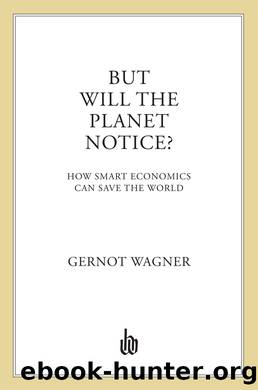But Will the Planet Notice?: How Smart Economics Can Save the World by Gernot Wagner

Author:Gernot Wagner [Wagner, Gernot]
Language: eng
Format: epub
Tags: Business & Economics, Environmental Economics, nature, Environmental Conservation & Protection
ISBN: 9781429969154
Google: Rl7My17y7-MC
Publisher: Farrar, Straus and Giroux
Published: 2011-09-27T23:57:33.410262+00:00
MONEY ON THE MIND
Sometimes price is not an issue. To this day, the Hubble Space Telescope and the Voyager space probe exploring the outer reaches of the solar system are lubricated by sperm whale oil, prized for its property of not freezing even in subzero conditions. NASA can afford to pay premium dollars to lubricate its space missions with the finest spermaceti and can write off the need for it as falling under scientific research rather than now-banned commercial whaling. For most everyone else, price is the deciding factorâas it should be. By 1850, the cheapest right whale oil cost $200 a barrel in todayâs dollars. The superior spermaceti cost a whopping $1,500, and the price was going up as the whales became more scarce.
Crude oil, by comparison, promised a bonanza. By the 1870s, it came in at under $100 a barrel in todayâs dollars, and the price went down from there. Throughout the twentieth century, oil mostly hovered around $20 a barrel before spiking during the Arab oil embargo in the 1970s and then again in the first decade of the twenty-first century.16
That latest rally has been particularly curious. If you wanted to know the price of oil in the early aughts, there was a simple rule of thumb: take the last digit of the year and add a zero. The year 2002 saw prices in the $20s; 2003 in the $30s; 2004 in the $40s. Prices climbed through 2007, when they reached the $70s. Then things overheated. Oil spiked above $140 in 2008 before crashing down to less than half that as the financial crisis hit. By this writing, they are back near $100, with many signs pointing up.
Some of this roller coaster was speculation, particularly at the height of the bubble in the summer of 2008. The general euphoria surrounding the housing and stock bubbles spilled over into commodities. The proof? Oil prices werenât the only ones spiking. Aluminum, barley, coffee, cocoa, copper, corn, cotton, gold, lead, oats, silver, tin, wheat, and plenty of others hit similar records. Commodities were flying high, largely fueled by a generally overheating economy.17 But not all of it was folly.
Much of the run-up in the first decade of the new millennium was due to fundamentals, the underlying factors that are chiefly responsible for any longer-term price movements: demand went up; supply didnât keep pace or even went down. Anyone interested in the main reason only had to look east.
Chinese oil consumption shot up by over 500,000 barrels a day in only three years, between 2005 and 2007.18 Thatâs not speculation. Thatâs physical barrels changing hands and being burned up to fuel hundreds of millions of people escaping poverty during the last throes of the fossil fuel age. By comparison, the United States, the most successful energy hawk in history, siphons off around 20 million barrels a day. Chinaâs demand crashed much like everyone elseâs during the global financial crisis, but it soon picked up steam again and by 2010 had surpassed the United States in total energy consumption.
Download
This site does not store any files on its server. We only index and link to content provided by other sites. Please contact the content providers to delete copyright contents if any and email us, we'll remove relevant links or contents immediately.
Zero to IPO: Over $1 Trillion of Actionable Advice from the World's Most Successful Entrepreneurs by Frederic Kerrest(4295)
Machine Learning at Scale with H2O by Gregory Keys | David Whiting(4179)
Never by Ken Follett(3790)
Harry Potter and the Goblet Of Fire by J.K. Rowling(3774)
Ogilvy on Advertising by David Ogilvy(3510)
Shadow of Night by Deborah Harkness(3303)
The Man Who Died Twice by Richard Osman(2997)
Book of Life by Deborah Harkness(2867)
The Tipping Point by Malcolm Gladwell(2827)
Will by Will Smith(2792)
0041152001443424520 .pdf by Unknown(2784)
My Brilliant Friend by Elena Ferrante(2774)
How Proust Can Change Your Life by Alain De Botton(2742)
Purple Hibiscus by Chimamanda Ngozi Adichie(2652)
How to Pay Zero Taxes, 2018 by Jeff A. Schnepper(2602)
Hooked: A Dark, Contemporary Romance (Never After Series) by Emily McIntire(2500)
Rationality by Steven Pinker(2291)
Borders by unknow(2229)
Can't Hurt Me: Master Your Mind and Defy the Odds - Clean Edition by David Goggins(2227)
